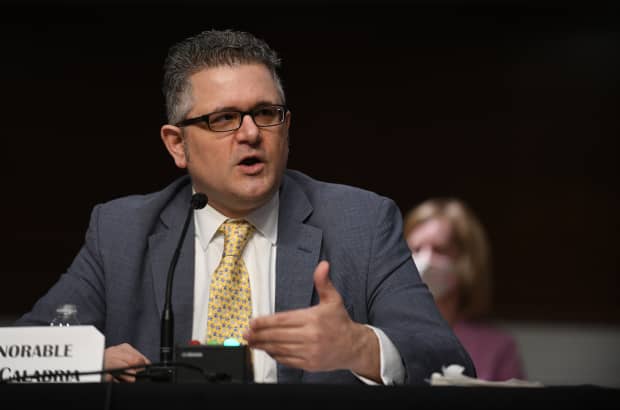
Mark A. Calabria, director of the Federal Housing Finance Agency, answers questions during a Senate Banking Committee hearing in June. Calabria is reportedly considering ending the conservatorship of Fannie Mae and Freddie Mac before Joe Biden assumes the presidency. (Photo by Astrid Riecken – Pool/Getty Images
Fannie Mae and Freddie Mac have been kept in conservatorship limbo for over a decade now. But the Trump administration may move to end that before leaving office in January.
In the wake of the government bailouts of Fannie Mae
FNMA,
+6.17%
and Freddie Mac
FMCC,
+6.60%,
the housing-finance giants were placed into conservatorship. The Federal Housing Finance Agency, a new regulator, was created to oversee the two companies’ operations as the companies recovered from the subprime-mortgage crisis and repaid the federal government.
In that time, Fannie and Freddie’s shareholders — other than
the federal government — have gone without even a single dividend payment. For
most of this time, Fannie and Freddie’s profits have been swept to the Treasury
Department.
Conservatorship was not intended to be a permanent thing. In April 2019, Vice President Mike Pence’s former chief economist, Mark Calabria, was confirmed as the director of the Federal Housing Finance Agency, the main regulator overseeing Fannie Mae and Freddie Mac. Since assuming that post, Calabria has moved to lay the groundwork needed to get the two companies out of conservatorship.
Don’t miss: What a Biden administration will mean for housing-finance reform
But with President Trump’s loss in the elections earlier
this month, a wrench was thrown in those plans. Former Vice President Joe Biden
is unlikely to be in any hurry to move Fannie Mae and Freddie Mac out of their
current arrangement.
Faced with that reality, Calabria appears to be considering a plan to move Fannie and Freddie out of conservatorship before the inauguration, according to a report from The Wall Street Journal.
Depending on how the exit is orchestrated, it could have a major impact on the housing finance ecosystem. Fannie Mae and Freddie Mac are not mortgage lenders — they buy and securitize mortgage loans, providing a crucial inflow of capital. All told, nearly half of all mortgages created in the first quarter of 2020 (47%) were backed by Fannie and Freddie, according to data from Inside Mortgage Finance and the Urban Institute.
“Director Calabria has previously been quoted as saying that
he believed the GSEs would be able to successfully exit the conservatorship
sometime in 2022,” said Rick Sharga, a mortgage industry veteran and executive
vice president at real-estate analytics firm RealtyTrac. “Accelerating the exit
by at least a year seems ambitious at best, and risky at worst, given the
critical role Fannie and Freddie play in providing mortgage market liquidity
and stability.”
Privatizing Fannie and Freddie requires the Treasury Department’s approval
The approach Calabria is likely to take doesn’t require
congressional approval — but would need the support of Treasury Secretary
Steven Mnuchin.
Last week, the FHFA released its finalized capital requirements
for Fannie Mae and Freddie Mac, setting the minimum target for equity that the
two companies should have to give themselves a buffer in a future economic
downturn. Altogether, the two enterprises should hold around $283 billion.
Currently though, they only have around $35 billion in capital, largely due to
the many years during which they swept all their profits to the federal
government.
Under typical circumstances, Fannie Mae and Freddie Mac
would need to hit that capital target before being privatized — a hefty goal.
But the FHFA could circumvent that formality by entering into a consent order
with the two companies, said Jim Parrott, a nonresident fellow at the Urban
Institute and owner of Parrott Ryan Advisors, a consulting firm that provides advice
on housing finance issues to financial institutions.
A consent order “is an agreement between the regulator and
the regulated entity where the regulator retains heightened oversight authority”
until certain requirements are met, Parrott said. In this case, that would be
Fannie and Freddie being recapitalized. The order would map out a plan for
Fannie and Freddie to achieve that goal.
Calabria’s stance is that ending conservatorship should be
driven by milestones rather than the calendar, an FHFA spokesman said.
To do this through consent order, the FHFA would need
Treasury to sign off. The federal government, through the Treasury Department,
owns over $200 billion in preferred shares of Fannie and Freddie. It’s through
those shares that the Treasury Department received dividend payments in the
past to recoup the funds used to bail the firms out.
“One of the terms of the backstop they now have between Treasury and [Fannie and Freddie] is that Treasury has to sign off on it,” Parrott said. It is unclear whether or not Mnuchin would support this measure, the Journal reported. Analysts believe that Biden’s Treasury Department would be unlikely to agree to such a plan — though it is not clear what opinions Biden’s rumored pick for Treasury Secretary, Janet Yellen, has on the matter.
If a consent order were to affect Treasury’s preferred
shares in Fannie or Freddie, that could come at the taxpayers’ expense. Back in
October, Sen. Mark Warner, a Democrat from Virginia, and Sen. Michael Rounds, a
Republican from South Dakota, sent a letter to Mnuchin and Calabria expressing
their concerns that taxpayers “are fully paid for any loss of ownership.”
Modifying Treasury’s shares would be critical in helping to
recapitalize Fannie and Freddie, since it will be difficult to reach the levels
required by the FHFA without considering a public offering of stock. As it
stands now, though, Fannie and Freddie shares hold little attractiveness to
investors since the conditions of the conservatorship mean they don’t receive a
dividend.
Overall, there are many “details that would need to be nailed down in a relatively short period of time — and during a pandemic, which is again threatening the economy and may require Treasury’s participation in negotiating a second government stimulus package,” Sharga said.
A sudden end to conservatorship could disrupt the mortgage market
The mortgage market doesn’t react positively to surprises or disruptions, to put it plainly. Last August, the FHFA announced it would be imposing a new 0.5% “adverse market” fee on refinance mortgages bought by Fannie Mae and Freddie Mac. The fee is intended to recoup money lost due to the forbearance that was extended to millions of homeowners affected by the COVID-19 crisis.
Originally, the FHFA said the fee would go into effect Sept. 1, just a couple weeks after it was announced. The news was met with criticism across the banking industry, as mortgage lenders took umbrage at the prospect of being charged the fee for loans where the rates had been locked in weeks prior. The FHFA eventually moved to delay the fee’s roll-out until Dec. 1, but before that announcement came mortgage rates began to increase.
“The announcement by the [Federal Housing Finance Agency] to apply a 0.5% fee to all mortgage refinance loans was one that caught lenders off guard, placing many in a difficult financial spot and forcing them to raise rates across the board — even for purchase loans, which aren’t directly affected by the new policy — in order to cover their losses,” Matthew Speakman, an economist with Zillow
ZG,
+2.56%,
said at the time.
While mortgage rates did eventually drop back down, before
decreasing to new lows, the saga surrounding the “adverse market” fee points to
the industry’s distaste for change.
Meanwhile, the housing industry has represented a significant
silver lining amid the economic crisis sparked by the coronavirus pandemic.
While home sales activity slowed in the first few months of the pandemic, it
roared back this summer. Record-low mortgage rates have fueled higher demand
among home buyers, driving home prices upward. The home-buying frenzy in recent
months has helped to stimulate the economy more broadly, as Americans have
spent money to spruce up or renovate their homes before listing them for sale.
Even a minor disruption to the housing-finance ecosystem could spoil that. “It would be extremely disruptive to the housing-finance system at a terrible time,” Parrott said. Rising COVID-19 cases threaten to set back the economic recovery from the pandemic or even create a second wave of job losses. Meanwhile, Congress has struggled to pass additional stimulus, and Treasury Secretary Steven Mnuchin has withdrawn emergency lending funds from the Federal Reserve.
“Here in the middle of all that
you would have a move that would unnerve [mortgage-backed securities] investors,
and that would likely drive up the cost of a mortgage because of MBS investor angst
— all of that would be happening at exactly the wrong time, when policymakers
are trying to do exactly the opposite,” Parrott said.
Privatizing Fannie and Freddie would limit Biden’s influence
It’s not clear what authority the
FHFA would retain under a consent order to guide the decisions made by Fannie
and Freddie on where to direct lending.
“Once you pull them out of conservatorship, it just gets a lot more complicated because they function more like normal, privately-owned institutions that have a great autonomy and independence,” Parrott said. “The Biden administration would possibly lose a really critical source for affecting housing-policy outcomes.”
Right now, the FHFA has a lot of
jurisdiction to set affordable-housing targets and other requirements that
Fannie and Freddie lend to a more diverse pool of borrowers.
Indeed, the actions the FHFA has
taken under Calabria could lead to fewer mortgages being backed by Fannie and
Freddie. The new capital requirements announced last week could cause
significant upheaval in the weeks and months to come.
Calabria argues the FHFA pursued the capital requirements to fulfill its statutory duties. “FHFA has the statutory authority and responsibility to put the Enterprises in a safe and sound financial condition, capable of remaining well-capitalized and well-regulated outside of conservatorship, while furthering the missions for which they were created,” Calabria said in his annual report to Congress this year.
Because more of Fannie and Freddie’s
profits must go now toward building their capital reserves, less money can be
directed back to lenders. It also reduces the incentives for Fannie and Freddie
to sell off their risk through credit-risk transfer deals, which could make
them riskier institutions, Parrott said.
“It will be more expensive for
those who get a mortgage that is bought by Fannie and Freddie — the cost of the
mortgage will go up,” Parrott said. “So you end up with these institutions that
will be not as supportive of the market generally, because they’ll be smaller
and providing more expensive access to credit.”
Wealthier borrowers might be priced out of Fannie and Freddie loans, but the money earned through these borrowers helps to subsidize lower-cost mortgages to lower-income households. Without those subsidies, low-income households may need to turn to other loan products, such as FHA loans, which are often more expensive. Before the capital rule was finalized, a group of consumer-advocacy organizations issued to a letter criticizing it for these reasons.
“The proposal would have a
disproportionate impact on people of color, intensifying pricing disparities
and making mortgage credit more expensive and less available, thereby aggravating
the racial wealth gap,” the letter stated.
The Biden administration may be
able to roll them back if it’s able to appoint a new FHFA director, pending the
results of an upcoming Supreme Court case.
“The Biden administration,
presumably, is going to want to get all regulators aligned around policy
efforts that are pushing in the same direction,” Parrott said.











































